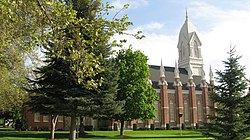
Brigham City is a city in Box Elder County, Utah, United States. The population was 19,650 at the 2020 census, up from the 2010 figure of 17,899. It is the county seat of Box Elder County. It lies on the western slope of the Wellsville Mountains, a branch of the Wasatch Range at the western terminus of Box Elder Canyon. Brigham City saw most of its growth during the 1950s and 1960s but has seen a struggling economy and stagnating growth. It is near the former headquarters of ATK Thiokol, now Northrop Grumman, the company that created the solid rocket boosters for the Space Shuttle.

Temple Square is a 10-acre (4.0 ha) complex, owned by the Church of Jesus Christ of Latter-day Saints, in the center of Salt Lake City, Utah. The usage of the name has gradually changed to include several other church facilities that are immediately adjacent to Temple Square. Contained within Temple Square are the Salt Lake Temple, Salt Lake Tabernacle, Salt Lake Assembly Hall, the Seagull Monument, and two visitors' centers. The square was designated a National Historic Landmark District in 1964, recognizing the Mormon achievement in the settlement of Utah.
William Harrison Folsom was an architect and contractor. He constructed many of the historic buildings in Utah, particularly in Salt Lake City. Many of his most prominent works were commissioned by the Church of Jesus Christ of Latter-day Saints. For a time he was sustained as the Church Architect, a calling in the church.
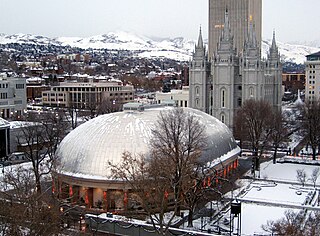
The Salt Lake Tabernacle, also known as the Mormon Tabernacle, is located on Temple Square in Salt Lake City, in the U.S. state of Utah. The Tabernacle was built from 1863 to 1875 to house meetings for the Church of Jesus Christ of Latter-day Saints. It was the location of the church's semi-annual general conference until the meeting was moved to the new and larger LDS Conference Center in 2000. Now a historic building on Temple Square, the Salt Lake Tabernacle is still used for overflow crowds during general conference. It is renowned for its remarkable acoustics and iconic pipe organ. The Tabernacle Choir has performed there for over 100 years.

The Vernal Utah Temple is the fifty-first temple of the Church of Jesus Christ of Latter-day Saints. The temple is located in Vernal and is the tenth LDS temple built in the state of Utah.

The Brigham Young Complex is a collection of buildings historically associated with the second President and leader of the LDS Church Brigham Young, on East South Temple in the center of Salt Lake City, Utah.
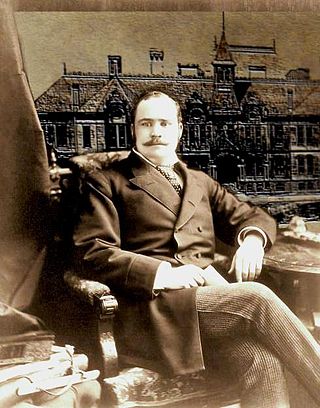
Joseph Don Carlos Young was an American architect and the Church Architect for the Church of Jesus Christ of Latter-day Saints from 1887 until 1893. In 1893, the office of Church Architect was dissolved, Young thereafter practiced privately with the LDS Church as a frequent client. Young practiced as an architect, landscape architect and designer from 1879 to circa 1935. A preponderance of his work centered on church commissions, or commissions offered him by extended Young family members, or higher echelon church friends.
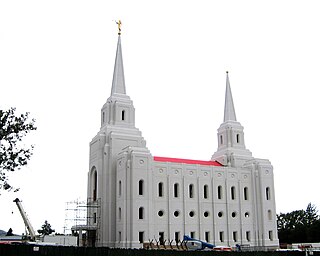
The Brigham City Utah Temple is a temple of the Church of Jesus Christ of Latter-day Saints in Brigham City, Utah. The temple was announced by church president Thomas S. Monson on October 3, 2009, during the church's general conference. The temple was announced concurrently with those to be constructed in Concepción, Chile, Fort Lauderdale, Florida, Fortaleza, Brazil and Sapporo, Japan; at the time, the announcement brought the total number of temples worldwide to 151. It is the fourteenth temple of the LDS Church completed in Utah.
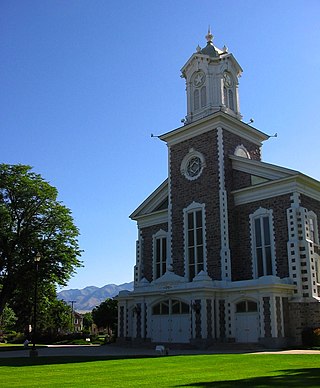
The Logan Tabernacle is a tabernacle of the Church of Jesus Christ of Latter-day Saints and is located in Logan, Cache County, Utah. It is used regularly for church meetings, most often semi-annual stake conferences, seminary graduations, musical concerts, and lectures. The tabernacle welcomes visitors and is open for tours each summer from June to September. It is the site of many local celebrations, including the city's annual Summerfest Arts Faire held each June on the tabernacle grounds.

Harvey H. Cluff (1836–1916) was a business, civic and educational leader in late-19th-century Provo, Utah.

The Provo Tabernacle was a tabernacle of the Church of Jesus Christ of Latter-day Saints from 1898 to 2010 in downtown Provo, Utah, United States. It was a historic icon of Provo and had been home to many religious and cultural events. All but the outer walls of the building were destroyed by fire in December 2010. The LDS Church preserved the remaining outer walls and built a new foundation and interior as part of the Provo City Center Temple, completed in 2016.

The Provo Third Ward Chapel is a historic building located in Provo, Utah. It was listed on the National Register of Historic Places on April 2, 1979.

The Bear Lake Stake Tabernacle, or Paris Tabernacle is situated on main street in Paris, Idaho, is a Romanesque red sandstone meetinghouse of the Church of Jesus Christ of Latter-day Saints designed by Joseph Don Carlos Young, the son of Brigham Young built between 1884 and 1889. The tabernacle was built by Mormon pioneers of Bear Lake Valley who used horse and ox teams to haul rock quarried from Indian Creek Canyon nearly 18 miles away. After the completion of the Logan Utah Temple in 1884, the workers began construction of the tabernacle. William Budge supervised the construction. It cost $50,000 to build and seats around 2000 people.
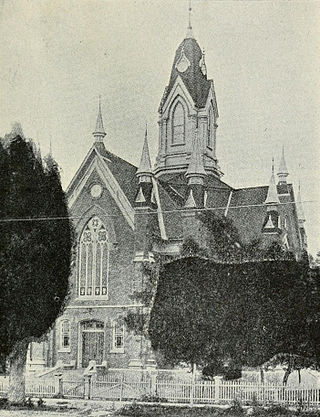
The Summit Stake Tabernacle or "Coalville Tabernacle" was a meetinghouse of the Church of Jesus Christ of Latter-day Saints located in Coalville, Summit County, Utah.

The Wellsville Tabernacle was built as a Gothic Revival-styled meetinghouse of the Church of Jesus Christ of Latter-day Saints and is located in Wellsville, Cache County, Utah. It was listed on the National Register of Historic Places on November 26, 1980.
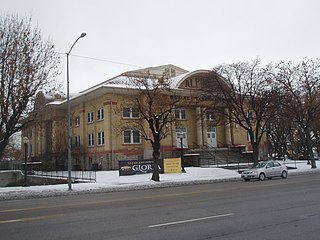
The Alpine Stake Tabernacle or Alpine Tabernacle, located at 110 East Main Street (US-89) in American Fork, Utah, United States, functions as a meeting place for large gatherings of members of the Church of Jesus Christ of Latter-day Saints in northern Utah County for worship services. The building is part of the American Fork Historic District listed on the National Register of Historic Places.
Harold William Burton was an early 20th-century architect with architectural works throughout the western United States and Canada. Burton was one of the most prolific architects of chapels, meetinghouses, tabernacles and temples for the Church of Jesus Christ of Latter-day Saints. In 1910 he opened an architectural firm with Hyrum Pope in Salt Lake City, Utah. They particularly appreciated Frank Lloyd Wright and the Prairie School architectural style. As young architects, Pope & Burton won design competitions for two of their better-known works, the Cardston Alberta and Laie Hawaii temples of the LDS Church. Burton moved to Los Angeles, California in 1927 to set up another office in the firm with Pope. After Pope unexpectedly died in 1939, Burton established a new firm with his son Douglas W. Burton. Together they continued to design many buildings, including some for the church, and in 1955 Harold Burton became the chief supervising architect for the LDS Church. One of his final works was the Oakland California Temple. Aside from places of worship, Burton designed civic buildings and homes. Many of his works exist today, some of which are listed on the National Register of Historic Places.
Lorenzo Snow Young, nicknamed "Bing", was a 20th-century architect in Utah. Young practiced for 40 years in Salt Lake City, Utah and is credited with having designed over 700 buildings.

The following outline is provided as an overview of and a topical guide to the Church of Jesus Christ of Latter-day Saints.

The Smithfield Tabernacle is a historic Church of Jesus Christ of Latter-day Saints (LDS) tabernacle and present-day recreation facility in Smithfield, Utah. It is one of 42 surviving LDS tabernacles out of 92 built. The building was a notable construction for a settlement of Smithfield's size, and it served as a geographic and symbolic center for the early town, functioning as an important religious and public space.
